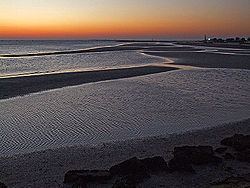Country Italy Elevation 2 m (7 ft) Time zone CET (UTC+1) Province Province of Gorizia Local time Saturday 1:26 AM Dialling code 0431 | Province / Metropolitan city Gorizia (GO) Demonym(s) Gradesi Area 114 km² Region Friuli-Venezia Giulia Postal code 34073 | |
 | ||
Frazioni Boscat, Fossalon, Pineta, Primero, Val Cavarera Weather 8°C, Wind E at 10 km/h, 78% Humidity | ||
Grado friuli venezia giulia adriatic sea italy
Grado (Venetian: Gravo, Latin: Gradus) is a town and comune in the north-eastern Italian region of Friuli-Venezia Giulia, located on an island and adjacent peninsula of the Adriatic Sea between Venice and Trieste.
Contents
- Grado friuli venezia giulia adriatic sea italy
- Map of 34073 Grado Province of Gorizia Italy
- History
- Main sights
- Resort town
- Twin towns
- References
Map of 34073 Grado, Province of Gorizia, Italy
Once mainly a fishing center, today it is a popular tourist destination, known commonly as L'Isola del Sole ("The Sunny Island"), also famous because it is also a spa town; together with Marano Lagunare, it is the center of the Marano-Grado Lagoon, which is famous for its uncontaminated nature. Grado is the birthplace of Biagio Marin, a poet who sang about the island in the local Venetian dialect.
History
In Roman times the city, known as ad Aquae Gradatae, was first port for ships entering the Natissa (Natisone), headed upstream to Aquileia.
Quite close is the ancient Roman city of Aquileia; during the late years of the Western Roman Empire many people fled from Aquileia to Grado in order to find a safer place, more protected from the invasions coming from the east. In 452, Nicetas, Bishop of Aquileia, took refuge briefly at Grado; of the same period is the earliest construction of Grado's first cathedral, the first church of Santa Maria delle Grazie, and the baptistery. Grado was the home base of the patriarchate's fleet.
In 568, after the invasion of the Lombards, the seat of the Patriarchate of Aquileia was transferred here by the Patriarch Paulinus. After the Schism of the Three Chapters, two different patriarchs were elected: the patriarch of Grado exerted his jurisdiction over the Latin-origin people living in the coast and in the Venetian Lagoon, while that of Old-Aquileia, later moved to Cividale, had its jurisdiction on the mainland. A long-lasting dispute over the authority of the two patriarchs ensued. In 993, the patriarch of Aquileia, Popo, conquered Grado, but was unable to keep possession of it. The matter was settled only in 1027 when the pope declared the supremacy of the See of Aquileia over Grado and the Venetian province.
The seat of the patriarchate was transferred to Venice in 1451 by Pope Nicholas V. Reduced to a minor hamlet, Grado was sacked by the English, who burned the city archives in 1810 and by the French in 1812. Grado was acquired by Austria in 1815, to which it belonged until 1918, when it was ceded to Italy after its victory in World War I.
Main sights
Today there are frequent finds of inscriptions, sarcophagi, marble sculpture and small bronzes that once furnished its villas. The remains of one of these villas has been excavated on the islet of Gorgo in the lagoon.
Modern landmarks include:
Of the ancient fortress only a tower, turned into a private residence, and parts of the walls can still be seen. Under the Town Hall are remains of the Palaeo-Christian basilica of Piazza Vittoria.
The Valle Cavanata Nature Reserve is a 327-hectare (810-acre) protected area situated in the easternmost part of the Grado Lagoon.
Resort town
Today, Grado attracts scores of tourists each year to its hotels and campgrounds. A large water park run by a municipal corporation is the main attraction, complete with indoor and outdoor swimming pools, and a health center offering spa treatments.
The town also boasts a well-preserved pedestrian-only center, in which many shops, bars, and restaurants are located.
Grado also offers facilities for many sporting activities, including tennis, wind-surfing, and golf. From Grado can be done excursions by boat to the Grado Lagoon, and visit the many dozen islands inside it (like Barbana).
